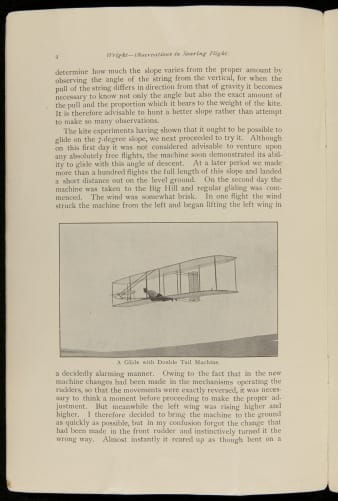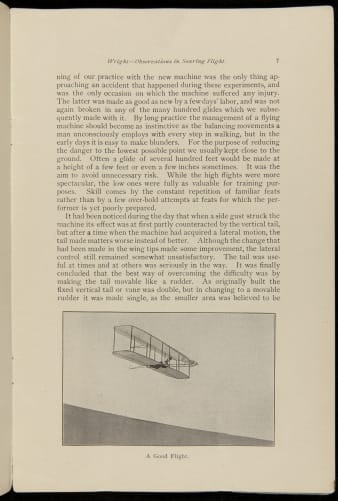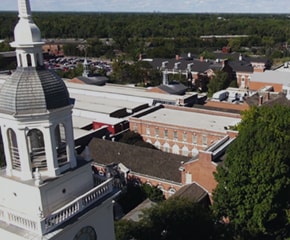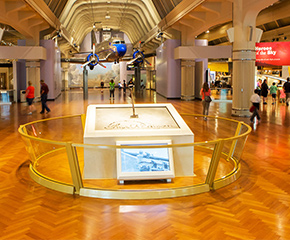
Wright Brothers Collection
The Wright Brothers collection is comprised of published material, photographs, and some correspondence, primarily from the period following the frist Wright brothers' flight on December 17, 1903.
Biographical / Historical Note
Wilbur and Orville Wright were the children of Reverend Milton Wright, a United Brethren Bishop, and his wife, Susan. They had two older brothers, Reuchlin and Lorin, and a younger sister, Katherine. Wilbur (1867-1912) was born in Millerville, Indiana,...
MoreWilbur and Orville Wright were the children of Reverend Milton Wright, a United Brethren Bishop, and his wife, Susan. They had two older brothers, Reuchlin and Lorin, and a younger sister, Katherine. Wilbur (1867-1912) was born in Millerville, Indiana, and Orville (1871-1948) was born in Dayton, Ohio.
During their childhood the two brothers shared mutual interests and were inseparable in their activities, which included making woodcuts, photography, printing and flying. Remarking on their home environment, Orville later said they were encouraged "to pursue intellectual interest; to investigate whatever aroused curiosity." Neither Orville nor Wilbur graduated from high school although they completed high school classes.
At the age of 14, Orville went into the printing business and was joined by Wilbur. The two brothers eventually built their own printing presses and published several weekly and daily papers. In 1892, they formed the Wright Cycle Co., selling and repairing bicycles. They began building their own bicycles in 1895. The money earned in their printing and bicycle businesses financed their experiments in flying.
During the years 1900 and 1901, Orville and Wilbur built their first two gliders and took them to Kitty Hawk, North Carolina, to test them. They experimented with glider flying for three years before attempting a powered flight. During this time they studied air pressures on curved surfaces and mastered how to control and fly a plane before applying power to it. On December 17, 1903, with five people in attendance, Orville made the first flight in a power-driven, heavier-than-air machine at Kitty Hawk, N.C. The flight lasted twelve seconds, covered 120 feet and soared 2-10 feet off the ground. The general public had little enthusiasm for their work so the two brothers went abroad where their planes were built by foreign governments, and they were acclaimed as heroes. Their hometown, Dayton, honored them in 1909 with a great celebration. The brothers eventually gained fame and recognition; however, they never attained subsequent flying achievements.
It's unknown when Henry Ford and Orville Wright first met. Henry Ford was evidently aware of the early aviation achievements of the two brothers. Ford, along with his son, Edsel, first became involved in the aviation industry when they backed William Stout in forming the Stout Metal Airplane Co. in 1923. When the Edison Institute was dedicated (1929), Orville Wright was among the guests. These contacts, and others, led Ford to move the Wright Brothers 1870 birthplace and late 19th Century Cycle Shop to the Institute in 1937-1938.
Wilbur Wright died in the family home of typhoid fever in 1912, just as the planes he and Orville were manufacturing received worldwide recognition. Orville Wright continued his work in the aviation field until his death in 1948.
LessScope and Content Note
The collection is comprised of published material, photographs, and some correspondence, primarily from the period following the first Wright brothers' flight on December 17, 1903. The collection contains seven series, covering the Wright-Langley controversy,...
MoreThe collection is comprised of published material, photographs, and some correspondence, primarily from the period following the first Wright brothers' flight on December 17, 1903. The collection contains seven series, covering the Wright-Langley controversy, the Wright Aeronautical Corporation, Henry Ford's purchase of the Wright Cycle Shop, and the dedication of the Wright home and cycle shop at Greenfield Village in Dearborn, Michigan, 1938.
Series I, the Wright-Langley Controversy series, contains papers regarding the Smithsonian Institution's early belief that Langley was the first to fly. Magazine, newspapers and letters cover the controversy which went on for approximately fifteen years. The Smithsonian Institution eventually recognized the Wrights were the first to fly, and the Wright Brothers then brought their plane from England for permanent display at the Museum.
Series II, the Wright Aeronautical Corporation series, includes items pertaining to the corporation, including brochures on many of the engines which they designed, a booklet and advertisement for their flight-school and a memorandum on the Curtiss-Wright Patent Suit.
Series III, the Orville Wright and Henry Ford Activities series, contains newspaper clippings and the paperwork surrounding Henry Ford's purchase of the Wright Cycle Shop and its movement to Greenfield Village. A list of the items received from Orville Wright is included. The Wright Dedication (April 16, 1938) at Greenfield) Village is also covered in this series. The preparation work for the ceremony, copies of the addresses by various speakers and photographs of the actual dedication events are found. One box of the series contains the Dedication Program, booklet for the Dedication Celebration and copies of a bound Dedication Book.
Series IV, the Scrapbook series, contains a number of scrapbooks/chronologies covering the Wright Brothers' activities from 1867-1933. These scrapbooks include articles from various newspapers and magazines covering their earliest interest and experiments in flying to the years following Wilbur's death in 1912.
Series V, the Photographs series, consists of photographs of various activities of the Wright brothers. The series includes a photograph of the first historic flight at Kitty Hawk, North Carolina, in 1903 as well as photographs of the celebrations and activities of the two brothers after that flight. Also included are photographs from a 1909 Dayton celebration, the Marker and Memorial Dedication at Kitty Hawk, and photographs of Henry Ford and Orville Wright.
Series VI, the Printed Matter series, includes magazine articles and newspaper clippings. Every subject involving the two brothers is covered including their aviation activities, relationship with the Smithsonian and activities honoring them in later years.
Series VII, the Miscellaneous series, includes a variety of items related to the Wright brothers. Items include a telephone directory printed by the Wrights, magazines originally printed by the Wrights, fabric from the original Kitty Hawk plane, and information from an interview with Orville concerning shop locations, companies and their birthplace. An oversized box contains newspaper clippings, including The Evening Item, June 12, 1890, printed by the Wrights.
LessCollection Details
Object ID: 82.300.1623.0
Creator: Henry Ford (Organization). Benson Ford Research Center
Inclusive Dates: 1867-2006
Size: 5.2 cubic ft., 2 oversize boxes and 1 framed item
Language: English
Collection Access & Use
Item Location: Benson Ford Research Center
Access Restrictions: The collection is open for research.
Credit: From the Collections of The Henry Ford.
Related Objects
Digitized Artifacts From This Collection
In many cases, not all artifacts have been digitized.
Contact us for more information about this collection.
Wright Brothers Piloting Their 1902 Glider in 1903, Kill Devil Hills, North Carolina
Artifact
Photographic print
Summary
The Wright brothers' 1902 glider was their third aircraft tested at Kill Devil Hills in as many years. It was also the first built with aerodynamic calculations based on the Wrights' own wind tunnel tests. The improvements in performance were stunning. The brothers made more than 700 glides in 1902. Many were over 500 feet long, and some exceeded 600 feet.
Creators
Object ID
P.B.34545
Credit
From the Collections of The Henry Ford.
Location
By Request in the Benson Ford Research Center
Get more details in Digital Collections at:
Wright Brothers Piloting Their 1902 Glider in 1903, Kill Devil Hills, North Carolina
What is The Henry Ford?
The national attraction for discovering your ingenuity while exploring America’s spirit of innovation. There is always much to see and do at The Henry Ford.
Portrait of Wilbur Wright, Le Mans, France, 1908
Artifact
Photographic print
Summary
Wilbur Wright was one of the most celebrated men in Europe after his series of spectacular demonstration flights at Le Mans, France, in 1908. Monarchs, politicians, and business tycoons came to watch his seemingly effortless mastery of the sky. Wright's cloth newsboy cap became a personal trademark and a fashion fad among stylish French men.
Creators
Keywords
Object ID
P.188.22635.F
Credit
From the Collections of The Henry Ford. Gift of Ford Motor Company.
Location
By Request in the Benson Ford Research Center
Get more details in Digital Collections at:
Portrait of Wilbur Wright, Le Mans, France, 1908
What is The Henry Ford?
The national attraction for discovering your ingenuity while exploring America’s spirit of innovation. There is always much to see and do at The Henry Ford.
Wright Airplane outside Hangar at Fort Myer, Virginia, September 1908
Artifact
Photographic print
Summary
While his brother was demonstrating their airplane in France, Orville Wright made demonstration flights of his own for the United States Army Signal Corps at Fort Myer, Virginia. All went well until September 17, 1908, when a cracked propeller caused the plane to crash. Orville survived with serious injuries, but passenger Lt. Thomas Selfridge was killed -- the first airplane fatality.
Object ID
82.300.1623.2
Credit
From the Collections of The Henry Ford.
Location
By Request in the Benson Ford Research Center
Get more details in Digital Collections at:
Wright Airplane outside Hangar at Fort Myer, Virginia, September 1908
What is The Henry Ford?
The national attraction for discovering your ingenuity while exploring America’s spirit of innovation. There is always much to see and do at The Henry Ford.
Wright Brothers Memorial, Kill Devil Hills, North Carolina, 1928-1929
Artifact
Photographic print
Date Made
1929
Summary
This monument marked the spot where Wilbur Wright assembled the Wright brothers' first experimental glider in 1900. The marker was the brainchild of William Tate, who hosted the Wrights on their trips to North Carolina. Funds for the monument were raised entirely by the citizens of Kitty Hawk, ensuring that it was a local tribute to the pioneering aviators.
Creators
Object ID
82.300.1623.7
Credit
From the Collections of The Henry Ford.
Location
By Request in the Benson Ford Research Center
Get more details in Digital Collections at:
Wright Brothers Memorial, Kill Devil Hills, North Carolina, 1928-1929
What is The Henry Ford?
The national attraction for discovering your ingenuity while exploring America’s spirit of innovation. There is always much to see and do at The Henry Ford.
Wilbur Wright at Le Mans, France, with Ernest Zens, a Balloonist, circa 1908
Artifact
Photographic print
Summary
After his impressive demonstration flights at Le Mans, France, in 1908, Wilbur Wright became one of the most celebrated men in Europe. Monarchs, politicians, and business leaders came to see him fly, as did fellow aviators. Wright took more than 40 passengers up into the sky with him during his French flights, including balloonist Ernest Zens.
Creators
Keywords
Object ID
82.300.1623.12
Credit
From the Collections of The Henry Ford.
Location
By Request in the Benson Ford Research Center
Get more details in Digital Collections at:
Wilbur Wright at Le Mans, France, with Ernest Zens, a Balloonist, circa 1908
What is The Henry Ford?
The national attraction for discovering your ingenuity while exploring America’s spirit of innovation. There is always much to see and do at The Henry Ford.
Pamphlet, "Experiments and Observations in Soaring Flight," Wilbur Wright, 1903
Artifact
Book
Date Made
August 1903
Summary
Theories and research on aviation were shared widely through professional journals. While conducting their experiments, Wilbur and Orville Wright read almost everything they could find, and Wilbur contributed his own articles on the brothers' work. This August 1903 article, based on Wilbur's June 1903 presentation to the Western Society of Engineers, describes their successful glider flights of 1902.
Object ID
38.560.35
Credit
From the Collections of The Henry Ford. Gift of Ernest L. Jones.
Location
By Request in the Benson Ford Research Center
Get more details in Digital Collections at:
Pamphlet, "Experiments and Observations in Soaring Flight," Wilbur Wright, 1903
What is The Henry Ford?
The national attraction for discovering your ingenuity while exploring America’s spirit of innovation. There is always much to see and do at The Henry Ford.
Orville Wright and Katharine Wright Feeding Cattle at Pau, France, February 1909
Artifact
Photographic postcard
Summary
Orville Wright and Katharine Wright joined their brother, Wilbur, in France in early 1909. Wilbur had completed a series of impressive demonstration flights the previous fall, and the three siblings were celebrated throughout the country as heroes. Despite all the attention from monarchs, politicians, and business titans, the Wrights remained unaffectedly true to their Midwestern modesty.
Creators
Keywords
Object ID
82.300.1623.16
Credit
From the Collections of The Henry Ford.
Location
By Request in the Benson Ford Research Center
Get more details in Digital Collections at:
Orville Wright and Katharine Wright Feeding Cattle at Pau, France, February 1909
What is The Henry Ford?
The national attraction for discovering your ingenuity while exploring America’s spirit of innovation. There is always much to see and do at The Henry Ford.
Launching the 1902 Glider with Orville Wright Piloting, Kill Devil Hills, North Carolina
Artifact
Photographic print
Summary
The Wright brothers' 1902 glider was their third aircraft tested at Kill Devil Hills in as many years. It was also the first built with aerodynamic calculations based on the Wrights' own wind tunnel tests. The improvements in performance were stunning. The brothers made more than 700 glides in 1902. Many were over 500 feet long, and some exceeded 600 feet.
Object ID
P.B.34542
Credit
From the Collections of The Henry Ford.
Location
By Request in the Benson Ford Research Center
Get more details in Digital Collections at:
Launching the 1902 Glider with Orville Wright Piloting, Kill Devil Hills, North Carolina
What is The Henry Ford?
The national attraction for discovering your ingenuity while exploring America’s spirit of innovation. There is always much to see and do at The Henry Ford.
Book Used by the Wright Family, "Select Works of Thomas H. Huxley," 1886
Artifact
Book
Date Made
1886
Summary
Bishop Milton Wright maintained an extensive library in his Dayton, Ohio, home. His books ranged from scientific works like Charles Darwin's On the Origin of Species, to poems by Virgil, to novels by Mark Twain. Wright's sons, Wilbur and Orville, used the bishop's books on physics and ornithology to start their research on the problem of human flight.
Place of Creation
Object ID
38.792.80
Credit
From the Collections of The Henry Ford. Gift of Orville Wright.
Get more details in Digital Collections at:
Book Used by the Wright Family, "Select Works of Thomas H. Huxley," 1886
What is The Henry Ford?
The national attraction for discovering your ingenuity while exploring America’s spirit of innovation. There is always much to see and do at The Henry Ford.






































